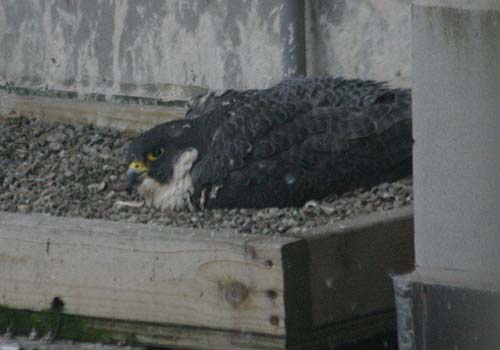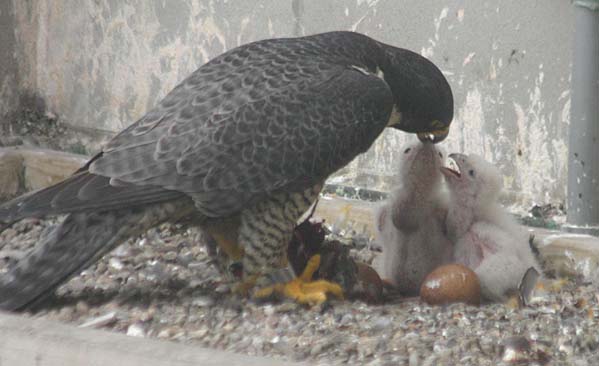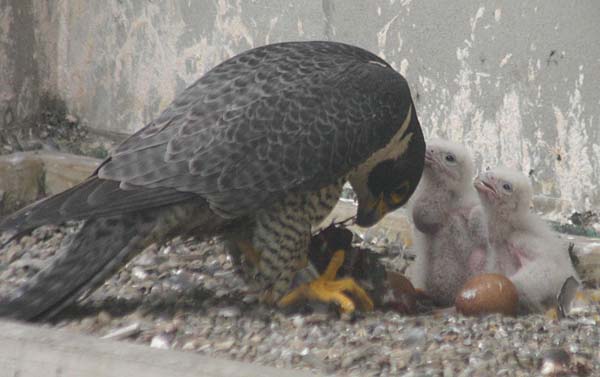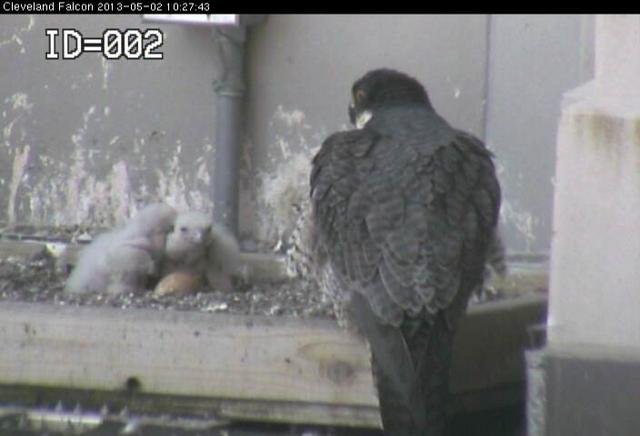FALCON FLASH
Dateline: Cleveland, Ohio
May 2, 2013
Click here to read what happened earlier
Watch the falcons live at: http://www.falconcam-cmnh.org/news.php
Our thanks to the Cleveland Museum of Natural History for sponsoring the FalconCams and for the still.
Photos are courtesy of Scott Wright, volunteer peregrine nest monitor. Video is courtesy of volunteer nest monitors Mr. and Mrs. Saladin. They may be used in any non-commercial publication, electronic or print, but please give photo credit.
SW and Boomer’s eyasses are about one week old. Volunteer nest monitor, Mr. Scott Wright, visited the nest yesterday and reports that SW and Boomer are feeding their youngsters very well. You can see the 2 remaining eggs, but by now we are sure they will not hatch.
For the first week or so, the eyasses can’t do much - except eat! Peregrine eyasses grow at an incredible rate. By the time they are six weeks old they will be as big as their parents. At first, the eyasses cannot self-regulate their body heat and the parents cover them whenever it is cool. Mr. Harvey Webster, Director of Wildlife Resources at the Cleveland Museum of Natural History, tells us that even with cold weather or heavy rain, “…..it is a tribute to S/W that she can create a warm and dry sanctuary for the chicks with her own body. The parents, in brooding the chicks, provide a source of warmth. In fact the temperature closest to the brood patch on S/W's abdomen might be close to 100 degrees F. The brood patch is featherless and highly vascularized to provide maximum surface area for heat transfer”.
SW spends most of her time keeping the eyasses warm and doing the feeding, and Boomer does most of the hunting at this point. There are several feedings per day. Mr. Webster tells us: “Peregrine Falcons have semi-altricial young meaning that though the young are comparatively helpless in their early nestling stage they still have to be active participants in the feeding process. Precocial birds like waterfowl are able to follow their mother from day one, are very well developed and feed themselves. Altricial birds are totally helpless at hatch. All they can do is simply thrust their beaks up whenever they sense the presence of a parent. Then the parent stuffs or regurgitates the food down the gaping nestling's mouth. With raptors, the adult will hold its prey in its talons, tear off a piece of meat with its beak and dangle it over the nestling. The chick must reach up and grab the morsel from the parent.” Mr. Webster also tells us: “A useful feature found in many species of birds (for when your eyes are bigger than your stomach) is a crop – a thin walled sac off the esophagus. Even after the stomach is filled during a meal, the bird can continue to eat. The extra food is stored in the crop. Then as the food in the stomach is digested, the food in the crop is moved to the stomach. This is particularly apparent in the downy young Peregrines. After a feeding by the parents the crops of the chicks will bulge outward just above their chests….”
In the following video, you can watch SW and her mate of several years ago, Buckeye, feed their eyasses. Usually it is SW that does the feeding, but in this case Buckeye was helping out. As you watch the clip, what observations can you make? Who gets feed first? Does SW have a method to how she feeds her little ones? http://s662.photobucket.com/user/CnCSal/media/SWnBucfeedn2.mp4.html?sort=3&o=42
With warmer weather, the parents may leave their little ones uncovered a bit more for us to see. If you monitor the FalconCams closely, you will notice changes in appearance and behavior. At one week, you can see they are already growing stronger. Soon you will see the little ones start to move around the nest.
Click here to read what happened next




